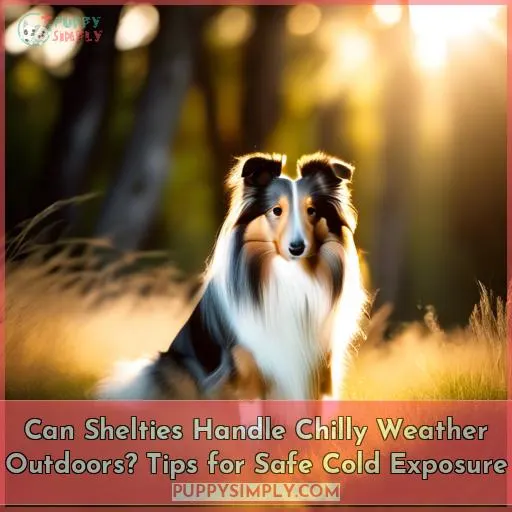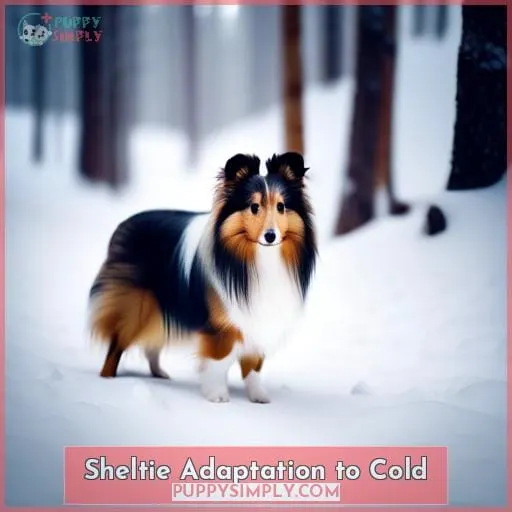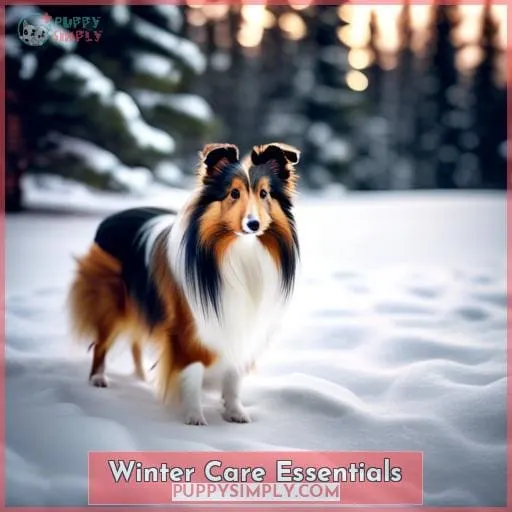This site is supported by our readers. We may earn a commission, at no cost to you, if you purchase through links.
 You walk outside on a frosty winter morning, your Sheltie eagerly bounding ahead.
You walk outside on a frosty winter morning, your Sheltie eagerly bounding ahead.
Their thick double coat billows in the wind, seemingly impervious to the cold.
But are they really?
Shelties thrive in cooler climates, yet freezing temperatures pose risks.
Monitor for signs of discomfort and ensure proper shelter.
Their adaptability has limits – help them stay cozy and safe.
Table Of Contents
- Key Takeaways
- Sheltie Adaptation to Cold
- Indoor Vs. Outdoor Living
- Winter Care Essentials
- Exercise and Outdoor Time
- Creating a Safe Environment
- Frequently Asked Questions (FAQs)
- How do Shelties handle extreme heat and humidity?
- Can Shelties be left outside for short periods during the day?
- Are Shelties prone to separation anxiety when kept outdoors?
- How can I provide my Sheltie with adequate exercise and mental stimulation if they are kept indoors?
- What are some common health concerns for Shelties that are kept outdoors?
- Conclusion
Key Takeaways
- Shelties are considered indoor dogs and thrive best when living inside with their owners, as they require close companionship and are not suited to being left outside for extended periods, such as overnight or while owners are at work.
- While Shelties enjoy outdoor activities and require exercise, they should not be left unsupervised outside due to risks such as coyote attacks, especially during the night when such dangers are more prevalent.
- Despite their natural cold tolerance thanks to their double coats, Shelties should not sleep outdoors in winter. They need a warm, dry, and comfortable indoor space to protect them from the harsh winter elements.
- Shelties are prone to separation anxiety and do not enjoy being left alone for long periods. They are highly social animals that need to engage in stimulating activities and prefer to be indoors with their family.
Sheltie Adaptation to Cold
As a breed originally from the Shetland Islands north of Scotland, Shelties have some natural tolerance for cold weather.
However, you must watch for signs they’re too cold like shivering and lethargy.
Issues like hypothyroidism can also reduce a Sheltie’s ability to regulate body temperature in the cold.
Breed’s Natural Cold Tolerance
Being an Arctic breed originally used for herding and protecting livestock in icy climates, Shetland Sheepdogs have a higher natural cold tolerance than many other breeds.
Their double coats provide excellent insulation against frigid temperatures.
However, individual Shelties can still vary in their ability to tolerate and adapt to the cold based on health, age, and other factors.
Limit continuous, unprotected exposure during extreme cold and look for signs of distress like shivering and seeking warmth.
Adjust outdoor time and increase calorie intake when very cold.
Most Shelties relish playing in the snow when properly acclimated.
Signs of Cold Sensitivity
You’ll know your Sheltie is cold sensitive if they shiver, seem anxious, or show signs of discomfort like lifting paws when outdoors.
Here are 4 key signs:
- Shivering or trembling, even when dry
- Appearing anxious or distressed in cold temps
- Frequent paw lifting or foot sensitivity on cold ground
- Seeking warm spots or attempting to get inside
These behavioral changes or physical symptoms can indicate your Sheltie struggles to regulate body temperature in the cold.
Factors like coat condition, time spent outdoors, and activity level impact cold tolerance.
If exhibiting cold sensitivity, ensure your Sheltie has indoor comfort and modify exercise based on weather.
Hypothyroidism and Cold Sensitivity
One should monitor their Sheltie for signs of hypothyroidism, as this condition can make them more sensitive to the cold.
If diagnosed, work closely with your veterinarian on proper hypothyroidism management.
- Medication adjustments
- Dietary considerations to support metabolism
- Modifying outdoor time and exercise in cold weather to prevent exacerbating existing symptoms
Look for behavioral changes like lethargy or sensitivities to temperature shifts that could signal a need for reassessment.
Thoughtful care can help hypothyroid Shelties stay happy and healthy despite cold sensitivity.
Indoor Vs. Outdoor Living
When keeping Shelties outdoors, recognize the breed’s vulnerability in cold temperatures.
As herding dogs with minimal body fat and fur insulation, Shelties rely on humans providing warm, indoor shelter.
Never leave your Sheltie outside unattended. Instead, bring them inside where you can monitor for signs of distress like shivering, weakness, or lethargy.
Risks of Outdoor Living
Transitioning from discussing their natural cold tolerance, you’d know Shelties shouldn’t be left outside for extended periods when it’s cold out, increasing their risk of hypothermia or frostbite.
Outdoor living leaves Shelties exposed to temperature fluctuations and precipitation.
Lack of adequate shelter puts their health at risk.
Being left alone outside can cause behavioral issues from isolation.
With their double coat, Shelties can regulate their temperature outdoors for short supervised play. However, leaving them outside unmonitored, especially overnight, should always be avoided to prevent dangerous cold exposure or accidents.
Providing a safe, warm indoor environment is essential for their health and wellbeing.
Importance of Indoor Shelter
You’ll want to provide your Sheltie access to indoor shelter when living outdoors during cold weather. An indoor shelter protects Shelties from the elements while allowing adequate warmth and comfort.
Benefits:
- Protection from wind, rain, snow, cold
- Access to food, water, bedding
- Climate control, warmth
- Socialization, mental stimulation
Examples:
- Insulated garage, mudroom, finished basement
- Heated garage, enclosed porch, dog door access
- Thermostat-controlled room, radiant floor heating
- Adjacent to family living spaces
Exposure to outdoor living in winter can be dangerous without proper shelter. Indoor shelter mitigates health risks and provides essential creature comforts.
Winter Care Essentials
You must protect your Sheltie’s coat and skin when exposing them to cold weather.
Their double coats provide insulation, but wind, wetness, salt, and ice can still damage skin.
Supplement the coat with a winter jacket or sweater for very cold or wet weather.
Coat and Skin Care
You’ll want to regularly brush their coat to remove dirt and distribute skin oils that moisturize skin and fur exposed by the cold.
Be sure to brush all the way down to their undercoat.
This helps fluff and air out the layers of fur for insulation.
Use a moisturizing shampoo and conditioner when bathing.
Limit full baths in winter but spot clean faces and feet often.
Brush out mats which can trap moisture and lead to skin irritation.
Apply a hydrating balm to paws, belly, and other exposed skin if needed.
Maintain their coat well so it protects their sensitive skin from winter’s drying effects.
Need for Winter Clothing
Regarding the need for winter clothing for Shelties:
Dress your Sheltie in a coat or sweater when temperatures dip below freezing.
Layered Protection:
- Insulated jackets provide warmth.
- Cozy sweaters under a windproof top coat prevent chilling.
- Thermal booties protect paws from icy surfaces.
Dressing your Sheltie in proper winter gear tailored for cold weather will help keep your pup comfy and content while outdoors.
Selecting items that:
- Provide insulation
- Block wind
- Keep extremities toasty
is key.
With the right winter wardrobe, your Sheltie can enjoy crisp air and brisk walks while staying safe.
Exercise and Outdoor Time
While shelties love to run and play, it’s crucial to monitor their cold weather outdoor exercise and time.
Watch for signs of frostbite on nose, ears, and paws or hypothermia symptoms like shivering.
Limit outdoors to short potty breaks if under 32°F or provide a coat and closely supervise play in snow.
Safe Outdoor Activities in Cold
Your Sheltie can enjoy safe outdoor activities in cold weather, provided you supervise and monitor for signs of hypothermia or frostbite.
Cold Weather Activities:
- Short walks
- Playing in snow
- Fetch games
- Training sessions
- Digging
Safety Tips:
- Limit time outside
- Provide a coat
- Check paws for ice
- Wipe off snowballs
- Bring water
Danger Signs:
- Shivering
- Lethargy
- Disorientation
- Pale gums
- Weakness
Engaging in winter play and snow adventures can be frosty fun for your Sheltie, as long as you ensure their health by monitoring for signs of cold stress and providing breaks indoors to warm up.
Monitoring for Frostbite and Hypothermia
During your Sheltie’s outdoor time in cold weather, you’ll need to monitor for signs of frostbite and hypothermia.
Watch for early frostbite symptoms like shivering and sensitivity or numbness in the extremities.
Check for hypothermia signs including weakness, confusion, and low body temperature.
Have warm blankets, towels, and hot water bottles ready to gradually rewarm affected areas.
Know when to call your vet – severe or prolonged exposure can quickly become dangerous.
Prevention measures, symptoms awareness, and a quick response are key to mitigating cold exposure risks.
Use proper clothing to keep your Sheltie cozy and safe.
Creating a Safe Environment
You’ll need to provide shelter and warmth for any outdoor breaks.
Adjust exercise times and duration to avoid extreme cold temperatures that could lead to frostbite.
Monitoring your Sheltie closely prevents overexposure when braving chillier weather together.
Shelter and Warmth for Outdoor Breaks
You’d be wise to ensure your Sheltie has access to warm shelter while taking brief outdoor breaks in cold weather.
Outdoor Shelters:
- Dog houses: Well-insulated shelters that protect from wind, snow, rain, and cold ground. Should have a door flap.
- Porches or garages: Can provide shelter if heated. Avoid drafts and cold concrete floors.
- Crates: Plastic airline-style crates hold in body heat. Cover crate with blanket for insulation.
Providing a warm, dry shelter is crucial when your Sheltie goes outside in winter. Use insulated dog jackets, thermal bedding, portable heaters, and other warming aids to keep them comfortable during outdoor breaks.
Adjusting Exercise in Extreme Cold
In extreme cold, you’ll need to adjust your dog’s exercise routine and limit time outdoors.
- Shorten walks or jogs significantly to 10-15 minutes maximum.
- Always bring a coat, booties, and paw balm for any outdoor time.
- Hold playtime and fetch indoors instead of outside.
- Monitor for signs of cold stress like shivering or seeking warmth.
- Never leave your Sheltie unattended in the backyard when it’s freezing.
Frequently Asked Questions (FAQs)
How do Shelties handle extreme heat and humidity?
Shelties can struggle in extreme heat and humidity, so it’s crucial to keep them cool.
Ensure they have access to shade and plenty of water.
Watch for signs of heatstroke, like heavy panting or lethargy, and act quickly to cool them down.
Can Shelties be left outside for short periods during the day?
Your Sheltie can enjoy brief outdoor moments,
but extended solo time isn’t wise.
They thrive on companionship and safety indoors.
Are Shelties prone to separation anxiety when kept outdoors?
Shelties, due to their high intelligence and strong bond with their owners, are indeed prone to separation anxiety, especially when left outdoors.
This can be mitigated by:
- Providing mental stimulation,
- Exercise, and
- Gradual desensitization to your absence.
How can I provide my Sheltie with adequate exercise and mental stimulation if they are kept indoors?
To keep your indoor Sheltie mentally and physically spry, think outside the box.
Transform your living room into a mini agility course, using cushions for jumps and tunnels for an obstacle course.
Dive into the world of scent games, hiding treats for a nose-powered treasure hunt.
Above all, weave these activities into your daily routine, ensuring your furry friend’s life is as rich and varied as a tapestry, full of engaging threads to explore.
What are some common health concerns for Shelties that are kept outdoors?
Shelties face various health risks when kept outdoors:
- Exposure to extreme temperatures
- Parasites
- Increased risk of injury or illness due to lack of supervision
Indoor living ensures a safer and healthier environment for your beloved Sheltie.
Conclusion
Would you look at that!
Despite the Sheltie’s cold-weather coat and adaptability, frosty outdoor environments pose risks not to be taken lightly.
Carefully monitor their exposure, provide warm shelter, adjust exercise, and supply protective outerwear when venturing into freezing temperatures.
With attention and preparation, your Sheltie companion can stay active and cozy this winter.











